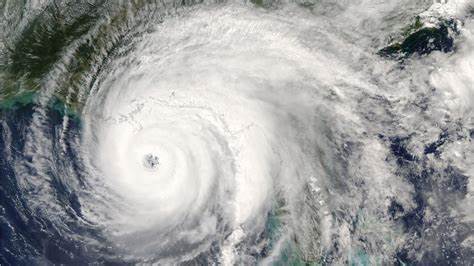(单词翻译:单击)
听力文本
Judy Woodruff: Hurricane Delta is lashing the U.S. Gulf Coast tonight. The Category 2 storm is expected to make landfall in Southwest Louisiana this evening. Outer bands have been hitting throughout the afternoon, dumping rain in towns and cities including Galveston in Southeast Texas and pounding Lake Charles in Louisiana with strong winds. This is the second hurricane to hit the region in just six weeks. It is also the fifth hurricane and 10th named storm to make landfall in the U.S. this season, making this one of the most active hurricane seasons in a century. Ken Graham is the director of the National Hurricane Center. And he joins me now from Miami. Ken Graham, thank you for joining us again. Give us the very latest on where Hurricane Delta is.
Ken Graham: Yes, the very latest formation we have, still 105-mile-an-hour winds, so still a significantly strong hurricane here. And we are right now getting part of the eye wall moving on shore in Southwest Louisiana, very close to where we had Hurricane Laura also make landfall. So, as that moves forward, you're going to see more of those hurricane-force winds move into Louisiana. And it's a big storm. So, so many people, Judy are going to feel the tropical-storm-force winds, in addition to that hurricane-force wind.
Judy Woodruff: So, tell us what you are most concerned, what people should be most concerned about here. Is it the water, is it the winds, or both?
Ken Graham: Well, it really is both, because, if you look at the situation, it's a large storm. Larger storms produce more storm surge. The tropical-storm-force winds extend out about 160 miles from the center. And, as a result, that onshore flow is really causing the water to rise. And looking at some of these locations, we already have six-foot rises with the storm surge. This is not even high tide yet. So, the storm surge, historically, is the leading cause of fatalities in these tropical systems. And some areas here along the Louisiana coast, Vermilion Bay, could get seven to 11 foot of storm surge. That's inundation. That's literally water above land that's normally dry.

Judy Woodruff: What about the speed at which this hurricane is moving? What does that tell you?
Ken Graham: It really is moving fast. It's been really a fast-moving storm for most of its life cycle. And, as a result, it's moving quickly. So, you will see some of those hurricane-force winds further inland because of that speed. But, as a result, when it moves that fast, it'll actually, you won't get as much rain. So, you're still going to get big rainfall totals, some areas getting six to 10 inches of rain, but, because it's moving fast, you will start seeing some of those tropical-storm-force winds impact much of Louisiana, Alexandria, up to Monroe, and eventually some of those winds even getting into Northern Mississippi.
Judy Woodruff: As we just said, Ken Graham, one of the most active hurricane seasons in history. How are all of you at the Hurricane Center dealing with this? How do you see this?
Ken Graham: It has been busy. I mean, you think about breaking the record, as soon as we make landfall, breaking the record from 1916, with 10 landfalls in the U.S. We're working them. I mean, it's like, it's been all hands on deck. We're getting it done, and, really, just everything we could do to keep ourselves safe, to make sure we could keep everybody safe out there from these hurricanes.
Judy Woodruff: And there are always storms coming behind this one.
Ken Graham: Exactly. We still have a ways to go, Judy, in this hurricane season. So, it ends at the end of November. So, we got to keep our plans in place. We got to still watch the Tropics.
Judy Woodruff: Ken Graham at the National Hurricane Center, thank you so much.
Ken Graham: Thank you.
重点解析
1.concerned about 担心
This aggression is the real issue the world should be concerned about. We want to keep that in focus
这次侵略才是世界应该关注的真正问题。我们想继续保持关注。
2.in place 准备就绪
One of the main findings of the survey was the confusion about the facilities already in place
这项调查的一个主要发现就是对于哪些设备已经到位搞不清楚。
3.break record 打破记录
Nobody can break his record for the long distance run.
无人能破他的长跑记录。
4.as a result 因此
Her hair started falling out as a result of radiation treatment.
由于放疗,她开始掉头发。
5.fast-moving 快速移动
Davies has managed to pursue his diverse interests in parallel with his fast-moving career
戴维斯在事业突飞猛进的同时并未放弃自己广泛的兴趣爱好。
参考译文
朱迪·伍德拉夫:飓风“德尔塔”今晚袭击美国海湾沿岸。预计今晚路易斯安那州2级风暴将在西南部登陆。整个下午都有外星带袭击,在城镇中倾盆大雨,包括得克萨斯州东南部的加尔维斯顿和路易斯安那州的查尔斯湖。这是六周内袭击该地区的第二次飓风。这也是本季登陆美国的第五次飓风和第十次命名风暴,这是一个世纪以来最活跃的飓风季节之一。肯·格雷厄姆是国家飓风中心的主任。他现在在迈阿密接受访问。肯·格雷厄姆,谢谢你接受我们的采访。告诉我们飓风“德尔塔”的最新情况。
肯·格雷厄姆:是的,我们最新的飓风情况,风速仍然是每小时105英里,所以这里仍然是一个非常强的飓风。我们现在正在路易斯安那州西南部的海岸上移动眼墙的一部分,非常接近飓风劳拉登陆的地方。所以,随着这一进程的推进,你将会看到更多的飓风风力进入路易斯安那州。这是一场大风暴。所以,这么多人,朱迪将感受到热带风暴的强风,除了飓风力的风。
朱迪·伍德拉夫:所以,告诉我们你最关心的是什么,这里的人们最应该关心的是什么。是水,是风,还是两者兼而有之?
肯·格雷厄姆:嗯,事实上两者都有,因为,如果你看看形势,这是一场大风暴。较大的风暴会产生更多的风暴潮。热带风暴强风从中心向外延伸约160英里。因此,陆上的水流确实导致了水的上升。看看这些地方,我们已经有6英尺高的风暴潮。现在还没到高潮。从历史上看,热带风暴的主要死因是风暴潮。路易斯安那州海岸的一些地区,朱砂湾,可能会有7到11英尺的风暴潮。那是洪水。这实际上是陆地上通常是干燥的水。
朱迪·伍德拉夫:飓风移动的速度如何?这说明了什么?
肯·格雷厄姆:它真的进展很快。在其生命周期的大部分时间里,它都是一场快速移动的风暴。因此,它的发展很快。所以,你会看到一些飓风力的风,因为它的速度而进一步向内陆移动。但是,结果,当它移动这么快的时候,它实际上-你不会得到那么多的雨水。所以,你仍然会得到大量的降雨量,一些地区会有6到10英寸的降雨量,但是,因为它移动的很快,你会看到一些热带风暴的强风影响路易斯安那州的大部分地区,亚历山大里亚,直到门罗,最终这些风甚至会进入密西西比州北部。
朱迪·伍德拉夫:正如我们刚才所说,肯格雷厄姆,历史上最活跃的飓风季节之一。你们在飓风中心是怎么处理的?你怎么看这个?
肯·格雷厄姆:一直很忙。我是说,你想打破纪录,一旦我们登陆,打破1916年以来的记录,在美国登陆了10次,我们正在努力。我是说,这就像是-所有人都在甲板上。我们正在完成任务,而且,真的,我们会尽我们所能保护我们自己的安全,以确保我们能让每个人都在飓风中安全。
朱迪·伍德拉夫:在这之后总会有暴风雨。
肯·格雷厄姆:确切地。朱迪,在这个飓风季节,我们还有一段路要走。所以,11月底结束。所以,我们得把计划做好。我们还是要看热带。
朱迪·伍德拉夫:国家飓风中心的肯·格雷厄姆,非常感谢你。
肯·格雷厄姆:谢谢您。
译文为可可英语翻译,未经授权请勿转载!


